100 Years of General Relativity (Part 1 of 3)
SCIENCE, 14 Dec 2015
Don Barrett, WSWS – TRANSCEND Media Service
“Thus, the general theory of relativity as a logical edifice has finally been completed.”
—Albert Einstein, November 25, 1915
7 Dec 2015 – These words were spoken by Albert Einstein one hundred years ago, concluding a series of four lectures at the Prussian Academy of Sciences in Berlin on a new theory of universal gravitation, extending and amending the work Isaac Newton published 228 years earlier. In the accompanying paper, Die Feldgleichungen der Gravitation (The Field Equations of Gravitation), Einstein published for the first time the final and correct equations for what would come to be known as the general theory of relativity. This work, an elaboration on the special theory of relativity worked out ten years previously, remains one of the two central pillars of modern physics.
While the scientific community pursued and studied this work, the Great War raged in its second year. Rationing, hunger and international isolation were features of everyday life. Physicists such as Karl Schwarzschild were deployed on the various fronts. Two years later would see the conquest of political power by the masses under the leadership of the Bolshevik Party in Russia, redefining the political landscape for the rest of the century.
Produced in a revolutionary epoch, general relativity continues to be regarded as one of the momentous achievements of physics, yet its implications are far from exhausted. Even after the passage of a century, new insights connecting the theory and observed phenomena appear each year in the publications of thousands of physicists across the globe. It was the capstone to a century of intellectual struggle and the catalyst to a deeper understanding of the material world.
Einstein’s work did not emerge in isolation. The growth of 19th and early 20th century science was inseparable from the technical innovation driven by the engine of capitalism during the period of its rise as an economic system. The first high accuracy refracting telescope, built by Joseph Fraunhofer and installed at Tartu in 1824, was a derivative of the surveying theodolite, the essential tool for dividing up land and marking national boundaries. High accuracy clocks and sextants, necessary for quantitative astronomical measurements, were initially treated as strategic secrets of state because of their critical role in navigation. The invention of the telegraph allowed for closer and more immediate collaboration among astronomers both within their respective countries and across national borders. As these new more precise technologies emerged, questions regarding humanity’s understanding of matter could be revisited.
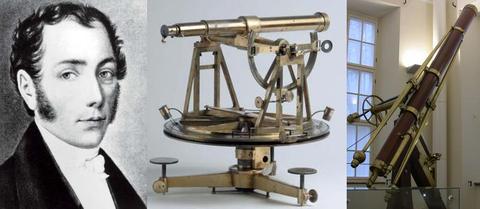
Joseph von Fraunhofer (1787-1826) together with his surveying theodolite and his Tartu refractor of 1824, the first modern telescope.
This led to a renewed interest in theories of planetary motion, which are the origins of the study of gravity. Ptolemy begin this work in the second century BCE when he explained the positions of the known planets in the sky by a sort of clockwork motion of planets in concentric and slightly offset circles; this theory survived for 15 centuries. It was overturned by Johannes Kepler on the basis of a slight yet critical discrepancy of its predictions, which led Kepler to a “road to a complete reformation of astronomy.” His new theory not only correctly described the motion of the planets through the sky, but concluded that their paths in space must be ellipses around the Sun. Galileo’s observations of Jupiter’s four largest moons showed that Kepler’s theory was correct not just for planets orbiting the Sun, but for moons orbiting planets.
Newton provided a deeper understanding of the elliptical motion by reducing it to a simple and universal law of force between the Sun, the planets, in fact everything in nature, varying with the masses and distances of the attracting bodies. To elaborate the implications of his theory, Newton, alongside the German mathematician Gottfried Wilhelm Leibniz, developed an entire new branch of mathematics, differential and integral calculus. Newton’s theory, combined with the new precision of 19th century technique, culminated in the discovery in 1846 of Neptune, a planet whose existence was deduced from its slight effect on the motion of Uranus by mathematical analysis. The French scientist and republican François Arago famously remarked that Neptune had been discovered “with the point of [a] pen.”
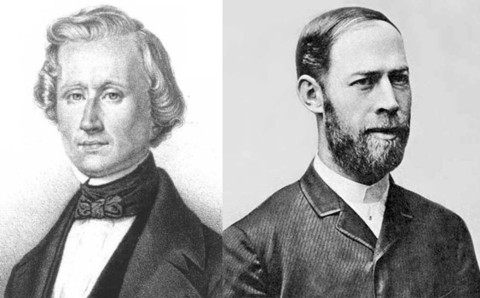
Urbain Le Verrier (1811-1877) who (with John Couch Adams) predicted the existence of Neptune using Newton’s Laws, and who measured an unexplained discrepancy in Mercury’s orbit, and Heinrich Hertz (1857-1894) who discovered radio waves and showed their velocity to be the same as that of light.
But contradictions to Newton’s theory began to develop through the 19th century. Urbain Le Verrier, one of the astronomers who predicted Neptune’s orbit, noted that the motion of the Mercury, the innermost and most rapidly orbiting planet, was deviating very slightly from its predicted path. Most of the deviation could be specifically calculated and modeled away as due to tugs from the other planets; the remainder, an effect of only seven percent of the whole, remained unexplained. Searches were made for an undiscovered inner planet adding its own perturbations. None has ever been found.
Other areas of 19th century physics were challenged by discovery after discovery tied to improvements in technique and materials. Hitherto unknown types of radiation were detected, not directly by the human senses, but by their physical effects. Thus 1799 brought the discovery of infrared rays; 1800, ultraviolet rays; 1886, radio waves; 1895, x-rays. The apparent stability of matter itself was shattered with the discovery of radioactivity by Henri Becquerel in 1896.
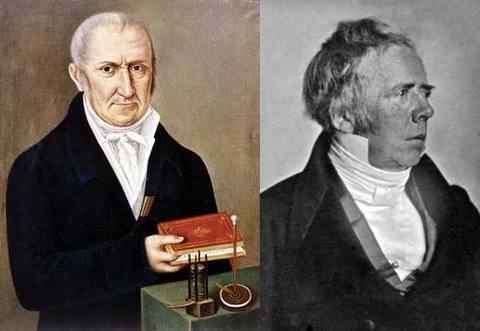
Alessandro Volta (1745-1827) whose “pile” was was the first battery to produce electrical current, and Hans Christian Ørsted (1777-1851), who showed current produces a magnetic effect.
The high point of this scientific turmoil was the discovery of two new types of universal forces: electricity and magnetism. Alessandro Volta’s pile, the first battery, was assembled in 1800. Flowing electricity was found to create magnetism by Hans Ørsted in 1820. Michael Faraday showed that changing magnetic fields created electricity in 1831, and thus created the basis for modern electrical power generation. Faraday also first described magnetism using the concept of a field of magnetic lines existing in definite physical relations with other forms of matter. Contemporaries viewed this field as merely a mathematical abstraction, but the later work of Maxwell and much of 20th century physics showed that fields do in fact exist as an independent material reality.
The full theory of these phenomena was worked out by James Clerk Maxwell, whose equations of 1861 and their refinement in 1865 would unify electricity and magnetism into a new theory of electromagnetism. This theoretical unity for a natural force was matched only by Newton’s work on gravitation, two centuries previously. The great physicist Ludwig Boltzmann gave some voice to the impact Maxwell’s contribution made when he quoted Goethe’s Faust: “Who was the god who wrote these lines?”
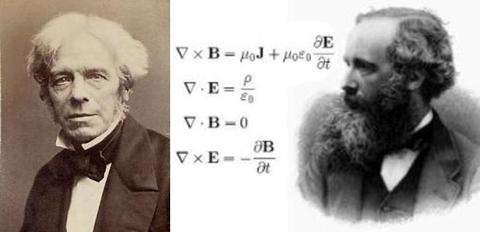
Michael Faraday (1791-1867), who showed a moving magnetic field produces an electrical current, and James Clerk Maxwell (1831-1879) whose famous equations (shown in modern form) provided a unified understanding of electromagnetic phenomena.
Maxwell’s equations, tested by Heinrich Hertz’s deliberate construction of equipment to produce and detect the predicted waves we now call radio, suggested the various other “rays” already discovered composed a common form as electromagnetic waves. What distinguished them was simply the wavelength between crests in an electromagnetic spectrum of radiation.
Into this ferment was born Albert Einstein in 1879, just months before Maxwell’s death. The young Einstein was captivated by Maxwell’s work. In autobiographical notes, he stated, “The most fascinating subject at the time I was a student was Maxwell’s theory.” Inspired by Maxwell’s study of light, a 16-year-old Einstein conducted his first significant gedankenexperiment (thought experiment). He imagined what it would be like to ride along such an electromagnetic wave at the same speed. Would it appear frozen, since the motion would be along its crest, like surfing along an ocean wave? The equations did not admit this possibility. More intriguingly, the theory of electromagnetism posited a fixed velocity—the speed of light—while Newton’s equations implied no such limit, instead describing the force of gravity operating with instantaneous effect.
Why should the form of the physical laws governing two different “fundamental forces” treat velocity so differently? By 1893 Oliver Heaviside would demonstrate that a modified theory of gravity incorporating a Maxwell-like speed limit must exhibit new behavior, including wave-like behavior. And what should the speed of Maxwell’s waves be measured against? These were questions posed to physicists as the end of the 19th century approached.
The speed of light had been measured crudely by Ole Rømer in 1676 by measuring the sixteen-minute difference in the clockwork motions of Jupiter’s moons from when Earth was on the near and far side of its orbit around the Sun. In 1879, Albert Michelson measured the speed of light not by using the natural motions of the solar system, but rather by reflecting pulses of light off a spinning mirror. By tuning the spinning rate, one could measure the speed. The accuracy of this technique was far above previous measurements: it was good to one part in six thousand.
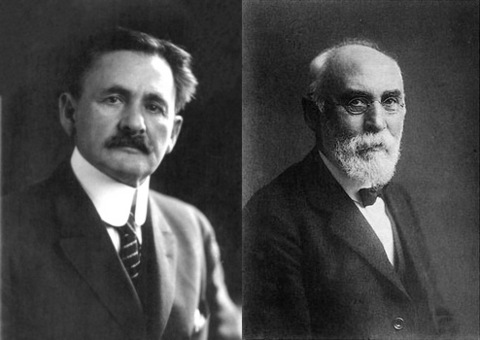
Albert Michelson (1852-1931), who experimentally showed light appears to move at the same speed even on a moving platform, and Hendrik Lorentz (1853-1928), who provided the first ad-hoc “corrections” to explain this puzzling result.
Ten years later, in 1889, Michelson, together with Edward Morley, used a variation of this device to compare the speed of light in two separate directions at the same time. It was assumed there was some stationary luminiferous aether through which the electromagnetic vibrations of Maxwell’s equations (i.e., light) propagated. The refined Michelson-Morley device could compare the speed of light going in different directions, this time to one part in sixty thousand. Since the Earth travels about the Sun at 30 kilometers per second, an enormous effect should have been seen in the speed of light measured along and perpendicular to the presumed aether. But, as Einstein would write in 1916, “the experiment gave a negative result—a fact very perplexing to physicists.”
Several physicists lent their efforts to construct ad-hoc “corrections” to explain the null result of the Michelson-Morley experiment. These would apply to moving bodies and cancel the expected measurements of aether drift. Hendrik Lorentz and George FitzGerald proposed a contraction in the scale of length with speed, such that an exact cancellation would occur against the expected difference in the speed of light as measured from a platform in motion. Such were the efforts to save the laws of electromagnetism from the realities of experimental results at the close of the century.
Einstein’s solution to the problem was both brilliant and profoundly radical. He recognized that there was a fundamental incompatibility between the way Newton and Maxwell expressed time and space in their theories, and he settled this conflict in favor of Maxwell rather than Newton. It would take a decade to fully work out the consequences. Here he was influenced by a physicist who became more famous for his philosophical speculations than his (significant) discoveries in the field of mechanics, Ernst Mach (1838-1916).
Mach explored through thought experiments the contradictions of Newton’s assumption of an absolute frame of reference, an absolute space and time against whose background the motion of objects could be measured. He contended that such an absolute space and time had no real physical meaning: motion was relative to an observer, not absolute. In considering Mach’s arguments, Einstein developed the understanding that observers who were not accelerating in relation to each other should see the same physical laws, and that this must hold for any development of new physics.
Mach took his denial of absolute space and time to an idealist conclusion philosophically, claiming that matter itself could not be considered an absolute, i.e., existing independently of the observer. The world, he claimed, consisted entirely of sensations and complexes of sensations. Lenin made Mach, and idealist philosopher Avenarius, the principal targets of his polemic in defense of dialectical materialism, Materialism and Empirio-Criticism.
Einstein did not follow Mach on his erroneous philosophical path. On the hundredth anniversary of Maxwell’s birth in 1931, Einstein opened his comments with following: “The belief in an external world independent of the perceiving subject is the basis of all natural science.”
Even as the philosophical debates carried on, the paradox of the Michelson-Morley “null result,” showing the same speed of light in all directions, and the deeper contradiction was resolved by Einstein’s special theory of relativity, published in 1905. (See: One hundred years since Albert Einstein’s annus mirabilis) Einstein’s boldest stroke was to assume as a basic postulate that observers in uniform motion would all see the same laws of physics from their individual perspectives, including the same speed of light. The germ of this project was found in Maxwell’s equations, with the speed of light serving as a critical natural constant.
One of the consequences of Einstein’s theory is that mass and energy, rather than subject to separate and independent conservation laws, are conserved together and are therefore at some fundamental level equivalent. This famous equivalence of mass and energy is expressed in the equation known across the world: E=mc2. The speed of light links small amounts of mass to enormous amounts of potential energy. Originally thought to be only of academic interest, this conversion was later carried out through the mechanism of the nuclear fission chain reaction. The energy released by the two atomic bombs dropped by the United States at the end of World War II, which each incinerated a city, was the equivalent of less than one gram of mass.
There was, however, a more daunting task. Einstein and his contemporaries had managed to recast the equations of electromagnetic physics so that different uniformly moving observers saw the same laws. The same approach would not work for gravitational physics. Newton’s equations still differed from Maxwell’s equations in that they implied instantaneous action, that is, infinite velocities. Special relativity had decisively shown that the fastest velocity was that of light, thus limited the speed at which even gravity could influence matter. Integrating these concepts into Newton’s work would occupy Einstein and the broader physics community from 1907-1915, even as the world political situation tobogganed towards catastrophe.
DISCLAIMER: The statements, views and opinions expressed in pieces republished here are solely those of the authors and do not necessarily represent those of TMS. In accordance with title 17 U.S.C. section 107, this material is distributed without profit to those who have expressed a prior interest in receiving the included information for research and educational purposes. TMS has no affiliation whatsoever with the originator of this article nor is TMS endorsed or sponsored by the originator. “GO TO ORIGINAL” links are provided as a convenience to our readers and allow for verification of authenticity. However, as originating pages are often updated by their originating host sites, the versions posted may not match the versions our readers view when clicking the “GO TO ORIGINAL” links. This site contains copyrighted material the use of which has not always been specifically authorized by the copyright owner. We are making such material available in our efforts to advance understanding of environmental, political, human rights, economic, democracy, scientific, and social justice issues, etc. We believe this constitutes a ‘fair use’ of any such copyrighted material as provided for in section 107 of the US Copyright Law. In accordance with Title 17 U.S.C. Section 107, the material on this site is distributed without profit to those who have expressed a prior interest in receiving the included information for research and educational purposes. For more information go to: http://www.law.cornell.edu/uscode/17/107.shtml. If you wish to use copyrighted material from this site for purposes of your own that go beyond ‘fair use’, you must obtain permission from the copyright owner.
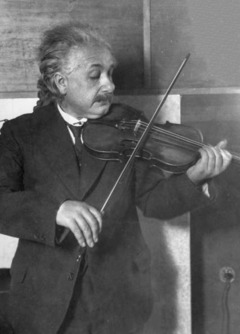
MAHAKAL; the great event is the manifestation of the vital energy in pre-cosmic dark atmosphere. It is the manifestation of darkness in darkness with cosmic wave movements. It has manifested first as radiant flame ‘Jyotirlinga’.
The Shiva Hiranyagarbha Golden seed
The creation is supported by ageless vital energy from cosmos just like a pillar ‘Skambh’ He is one and all. The Shiva in trance is personification of calm and quiet unfathomed dark cosmos. The manifestation of vital energy with radiant flame is ‘Jyotirlinga’. The golden seed is in the womb of flame Hiranyagarbh.
The Hiranyagarbha, the space in the womb became the lord of all created beings.
In the beginning rose Hiranyagarbha, born only Lord of all created beings.
Dark matter exerts gravity, but emits no light
One possibility is that the collision of dark matter is hidden within pre-cosmic deep darkness. It exerts gravity, but emits no light. The answer is in its quality to exert gravity. The creator has created the creation in his own image. The zero is the contribution of India to the world. It explore the underlying space Higgs field with zero mass imparted mass to elementary particles with formation of asteroids and planets, the source of existence of all.
He fixed and holds on this earth and heaven what God shall we adore with our oblation? (Rig. 10-121-1)
The ageless Shiva symbol is in fact the true nature and manifestation of time. It stimulates the event to happen. Its back ground is in ‘Purusha Sukta’ and Skambha Sukta Atharvaveda. It has kept alive the ancient cosmic knowledge and was worshipped as radiant flame ‘Jyotirlinga’ Lord of Creation. The grand unified force, and the ensign of existence of all. The idol worship of LORD OF CREATION was followed all over the world once as cosmic principle, and with time ‘Jyotirlinga’ restricted to symbol only.
The one become many with its dualistic force. The Brahma‡ intellectuals call him with different names. He is the soul and eye of the creation. Whose eye controls the whole creation from highest heaven, He is working just like eye grasp the image and stimulate thoughts in brain in multiple ways.